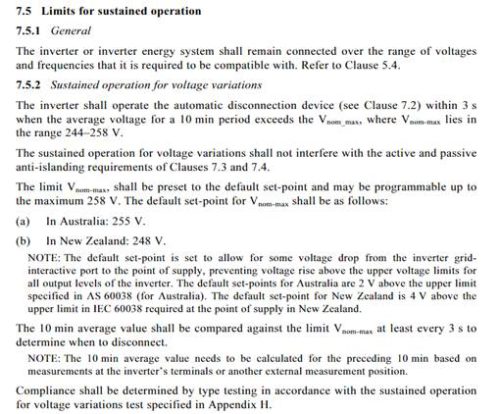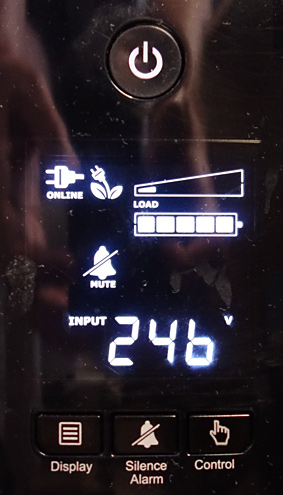Malfunctioning Tesla Powerwall? No, Malfunctioning Grid
March 7th, 2019Here’s another chapter in my endless saga related to the electric grid in the Far North of NZ.
About a week ago, I noticed that my Tesla Powerwall 2 was not discharging power to household loads, even though it had plenty of charge. It was going into “Standby” mode and the house was drawing power from the grid. This was happening mostly at night. Interestingly, when I shut off the grid connection to the house, the Powerwall functioned perfectly in off-grid mode.
I called Tesla and explained the situation. They installed some sort of diagnostic firmware on my Powerwall by remote control and a couple of days later informed me that my grid connection was periodically going into an overvoltage state that was out of specification for my country. The Powerwall system was working as intended and complying with rules related to grid connected inverters.
I asked for it in writing and Tesla emailed me the following:
From: PowerwallSupportNA
Thu, Feb 28, 11:30 AM
Hello,
I hope this email finds you well. This is ****** with Tesla Powerwall Support. I was reaching out in response to your request for support. The Powerwall is operating as intended. The issue is regarding the grid voltage that is out of range. The Powerwall is going into standby due to high grid voltage. Your grid voltage fluctuates between 239V-254V.
According to AS/NZ4777.2 ‘Grid Connection of Energy Systems via Inverters’ Clause 7.5.2 ‘Limits for Sustained Operation’, inverters shall automatically disconnect if the average grid voltage over a 10 minute period exceeds 248V, see excerpt from AS/NZ4777.2 below. Seeing as the Powerwall contains an inverter, we have to comply with the standard. The only way to fix this is to contact the DNSP/DNO. They usually launch an investigation and if they determine the grid is non-compliant, they will reduce the grid voltage at the transformer. If they determine otherwise, there is nothing we can do.
For further questions, please call us back at 877-961-7652 option 2 for Powerwall.
Kind regards,
Powerwall Technical Support
—
Next, I called the grid operator and explained that I was experiencing an overvoltage situation at my house. While the person on the phone wasn’t dismissive, I got a sense that she didn’t understand what was happening. I asked if she could pass an email from Tesla through to an engineer right now, because they need to know about this.
I emailed it through, she forwarded it to the control room and put me on hold. A few minutes later, it was all hands on deck.
A truck was out here the next morning.
Later that day, the voltage was brought down a bit—not to where it should be, but enough to keep my Powerwall online while connected to the grid.
It seems like they’re running higher voltages as a matter of routine to handle higher loads at peak times. We’re supposed to be getting 230v out of the wall here, but, even after the adjustments were made, the lowest voltage I’ve seen is 238v, and it still goes as high as 246v at night.
The legal limit is 230v + or – 6%, or 243.8v on the high end. Here’s a recent picture of my UPS, which shows the grid voltage:
In case you’re wondering, that’s a very high quality UPS from CyberPower, and my Kill-A-Watt and volt meter show the same thing.
So, it’s still bumping up against the redline sometimes. This affects dozens of residences around here.
I don’t want to write what the technician said who came out to my house when I asked about grid telemetry. To put it mildly: The end users reporting faults over the phone are the telemetry. He really appreciated that I was able to figure this out before it became a more serious problem.
“Thank Tesla,” I said.
I’m posting this as a sort of public service announcement. If you’re in NZ and you suspect something weird is happening with your grid connection, definitely look into it.
A few comments about the Powerwall 2 during this situation:
1) I asked Tesla why the Powerwall couldn’t treat grid overvoltage like a grid-down situation and run in backup mode until the voltage dropped back down again? There was a long pause and then a response that was something like, “It just can’t.” But it seems like a couple of lines of code on the gateway could fix that.
if grid voltage is greater than or equal to 248v for ten minutes then grid state = down
Relays go clunk and then we carry on in off-grid mode until the gateway senses that the voltage has come down again.
2) It would be nice if the Tesla app showed the reason for the Powerwall being in standby mode. It would be even nicer if the app allowed users to see grid voltage and frequency, with alerts for when the grid starts to go off the rails.
3) When I was running the house offgrid, the Powerwall was kicking out mostly 230v 50hz, right on the nose. Regardless of load, the voltage never deviated more than + or – 1v. Nice!



